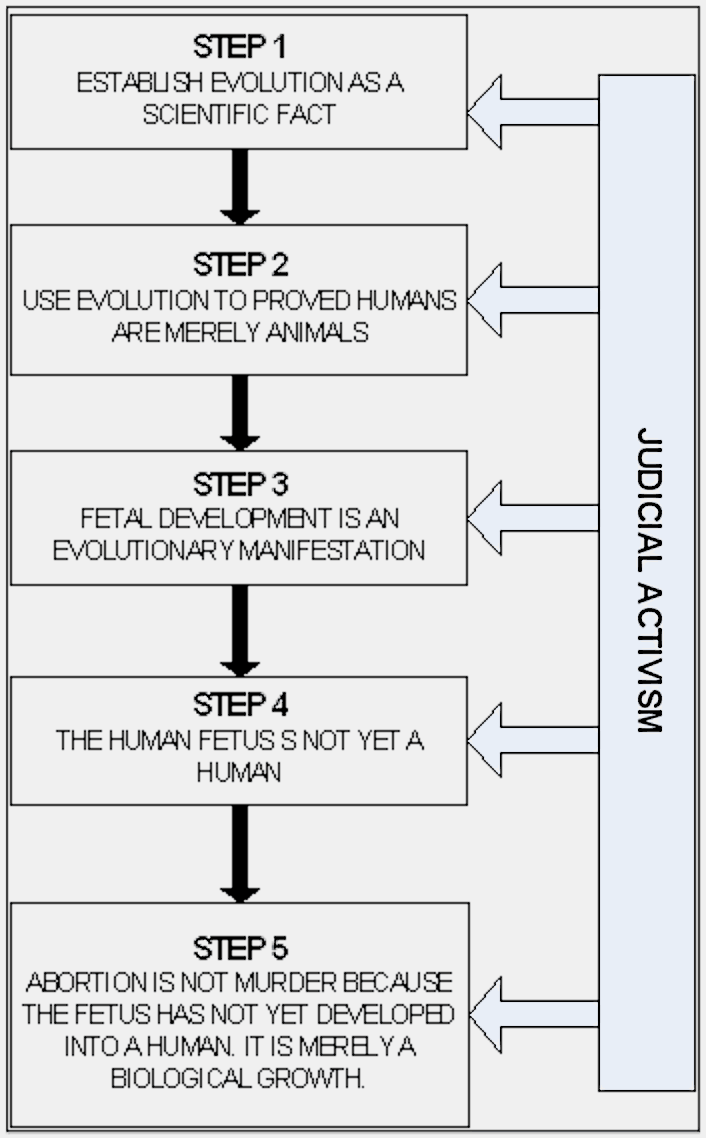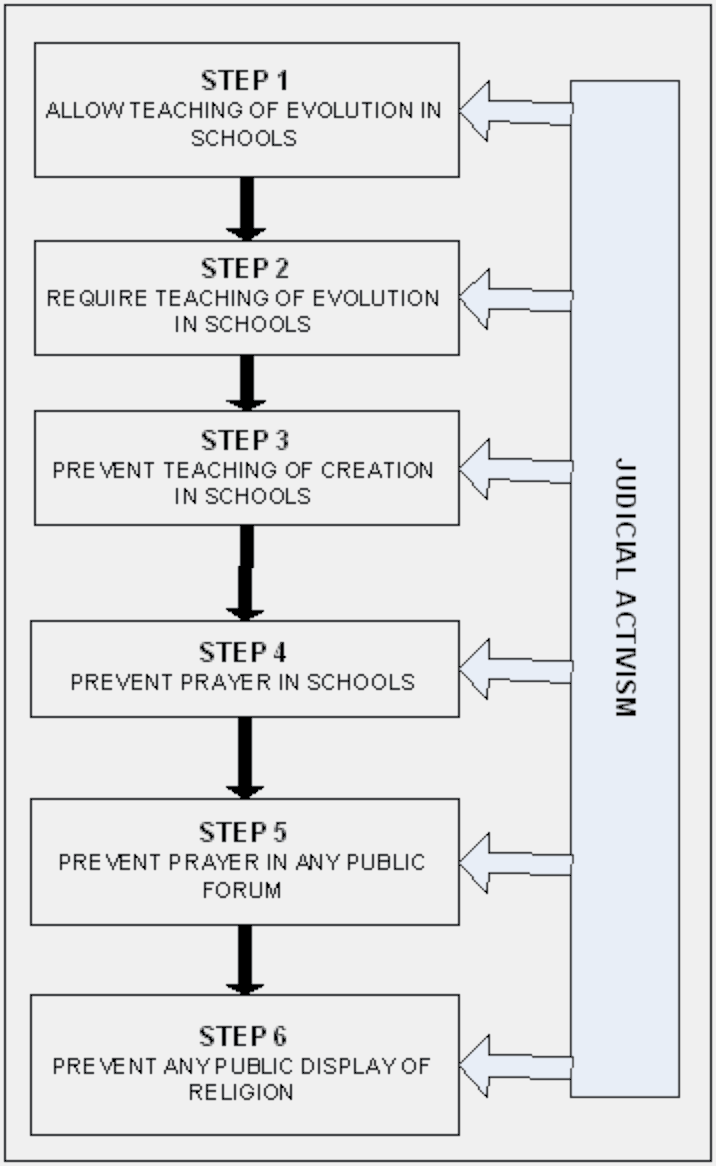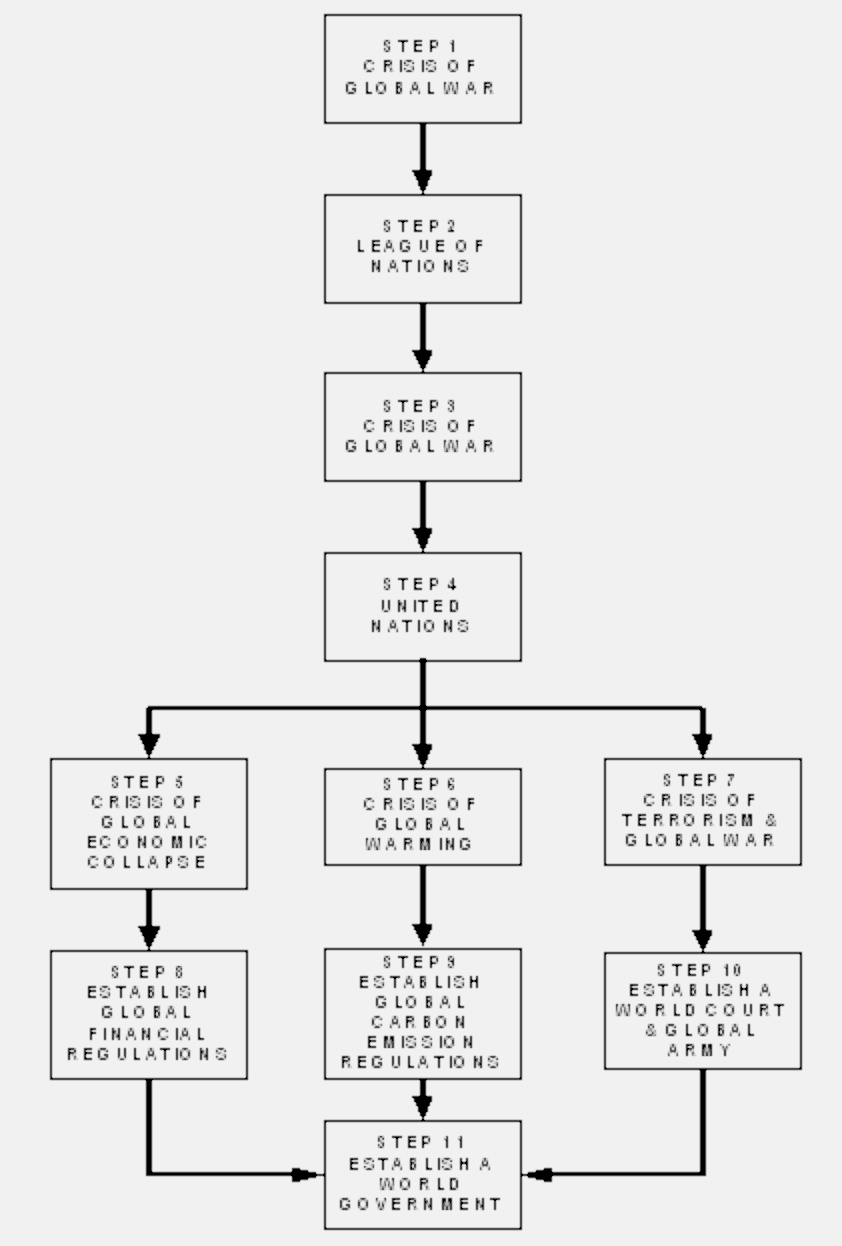Chapter 14
Down the Slippery Slope and Through the Back Door
Humanism vs. Christianity
The Polarization of America
by Patrick Vosse

Living Water at Christianity Oasis
John 7:38 He that believeth on me, as the scripture hath said,
out of his belly shall flow rivers of living water.

Part Three
Polarization of America
Chapter 14 - Down the Slippery Slope and Through the Back Door
The American public, and particularly Christians, would not accept much of the Humanist agenda outright. Politically, Americans were initially opposed to Marxism to the extent that in the middle of the 20th century many "Reds" were jailed for being un-American. However, by the end of the first decade of the 21st century, the White House is full of "Reds" (or, at least "Pinks") and is attempting, with some success, to implement the Progressive agenda. How did that happen? It happened through small steps that were often ignored. It happened through judicial decisions disguised as something else. It happened slowly and executed with patience. As the old Chinese saying goes, "A journey of a thousand miles begins with a single step." And, we might add, continues one small step at a time. When Humanists propose a change to a law that would only slightly compromise Christian values, Christians often challenge the change as the first step down the slippery slope to more significant moral compromise. Humanists, often with a sneer, counter with, "The slippery slope theory in all in your head." History proves, however, that concerns regarding the implementation of the Humanist agenda through slippery slopes are well founded. A few examples are given below.
Evolution to Abortion
The first part of the book was devoted to the Creation-Evolution debate. It might seem odd to devote so much of the book to just one issued in the Humanism-Christianity conflict, however, that issue is woven throughout the conflict and forms the foundation for many of the other issues, abortion is one.
At the beginning of the 20th century, until the '60s, abortion was taboo. Abortion was not accepted by society. It was done, but in secrete. It was illegal and the consensus was that it was murder because the fetus is an individual from conception. As the sexual revolution progressed in the '60s and 70's, the demand for abortion increased and became more acceptable by society. However, abortion could not be imposed directly because society was not ready for that. A gradual process with backdoor assistance from activist judges was called for. This is shown graphically in Figure 9.
Step 1. Establish evolution as a scientific fact.
By the mid-20's, evolution had already become controversial and there was considerable opposition to it; not just from the Christian community but from many scientists as well. The issue came to a head with the Scopes trial discussed earlier. If evolution could be introduced in the public schools as legitimate science, it would be an established principle and a legitimate foundation for Humanism. But conservative lawmakers imposed laws that prohibited the teaching of evolution in the public schools. The majority of the citizens were in agreement. The Scopes trial challenged the prohibition and the jury found Scopes guilty. He was fined 100 dollars. Most narratives end the story there, but the ACLU appealed the decision to the Tennessee Supreme Court. The court, in one of the earliest act of judicial activism regarding evolution, overturned the lower court and the decision of the jury; not because of the facts of the case, but because he decided the fine was excessive. The backdoor opposition to justice began the slippery slope of establishing evolution as legitimate within the common culture, if not the scientific community.
Step 2. Use evolution to prove that humans are merely animals.
The evolution hypothesis states that all organisms evolved from a single parent organism through a process of natural selection. All animals are different only by their evolutionary history. Humans are merely animals at an advanced stage of evolution (see Figure 8, above). Many Humanists would argue that humans have no more rights than other animals. If God is removed from the equation, an axiom for the Humanist, then Man is not unique among the animal kingdom except for his intelligence and even that is considered a natural extension of quantity, not quality. Decisions by judicial activists support this philosophy by reaffirming evolution by natural selection as a legitimate science and must be taught in public school.
Figure 9. The slippery slope from evolution to abortion.
Step 3. Establish that fetal development is an evolutionary manifestation and, in its early stages of development, the fetus is not fully human.
In 1876, a colleague of Darwin, Ernst Haeckel, published a book, General Morphology of Organisms, with the purpose of supporting Darwin's hypothesis. In the book, Haeckel introduced the Biogenetic Law. The Biogenetic Law proposes that the human embryo retraces the steps of evolution as it develops. The fetus, according to Haeckel, develops a yolk sac, tail, gills, and so forth, retracing the various stages of human evolution. He even presented drawings of these stages of fetal evolution. Later, Haeckel was exposed as a fraud, his drawings merely creative cartoons and his colleagues denounced the Biogenetic Law. Yet Humanists, using the same techniques that sold evolution to the public, continued the biogenetic myth. The children's doctor, Spock, mentioned earlier, continued the myth that was debunked decades earlier.
Each child as he develops is retracing the whole history of mankind, physically and spiritually, step by step. A baby starts off in the womb as a single tiny cell, just the way the first living thing appeared in the ocean. Weeks later, as he lies in the amniotic fluid of the womb, he has gills like a fish ...[1]
As late as 1986, the myth of biogenetics was circulating throughout the culture with the help of the reader's digest Book of Facts, which published the myth including Haeckel's cartoon drawings. It is in the interest of the Progressive to promote Haeckel's fallacy because it supports abortion. Biogenetics allows the Progressive to raise the question: If the fetus starts out as a simple organism and evolves, retracing the steps of human evolution, when does the fetus become a person?
Step 4. The human fetus is not yet human.
In 1973, fetal evolution became the center of the Supreme Court's decision. They stated that they could not determine when a fetus became a legal person (even thought for murder a fetus at any stage of development is a legal person) and divided the issue into three. In the first trimester, based on the assumption that since the fetus had not yet developed into a human (its DNA would argue that point), abortions could be legal for almost any reason. In the second trimester, because of the greater possibility of the fetus developing into a human, greater restrictions to the abortion would apply. In the third trimester, with the high probability that the fetus had developed into a human, abortions could only be performed under very limited conditions. Here is judicial activism based on bogus science that is discounted by embryologists but is accepted with a "wink and a nod" to further the Humanist agenda.
Step 5. Abortion is not murder because the fetus has not yet developed into a human it is merely a biological growth.
This thinking not only furthers the practice of abortion legally, it supports abortion psychologically. It is much easier to discuss the removal of the undeveloped tissue in the womb that to talk about killing the baby. This technique is universally used by family planning and abortion clinics and it is based on fraudulent science.
From Evolution to Anti-Christianity
In all of the examples discussed here, the mechanisms are much more complicated that presented and the chain of events shown are but a part of the total picture. However, they are a key factor in the slippery slopes discussed. Another chain of events implementing the Humanist agenda is the progression from the acceptance of evolution in our society to the restrictions placed on Christianity. This chain of progression is shown in Figure 10.
Figure 10. The slippery slope from evolution to anti-Christianity.
Step 1. Allow the teaching of evolution in public schools.
We discussed the inclusion of evolution in school curricula in Step 1 of the section above. The Scopes trial was the main factor in starting the slide down the slope. However, in 1968 the Supreme Court went even further in the case of Epperson v. Arkansas (1968), discussed above, where it ruled the Arkansas law prohibiting teaching evolution in public schools unconstitutional as establishing a religion. As mentioned previously, the Constitutional Establishment Clause applies to the federal government but does not apply to a state government. Judicial activism took a giant step towards the implementation of the Humanist Manifesto.
Step 2. Require the teaching of evolution in public schools.
There is a big difference between allowing evolution to be taught and requiring it to be taught. Among the cases mentioned in Chapter 8, two gave the Humanist the foothold they needed to establish Step 2. In Segraves v. State of California, (1981) and Peloza v. Capistrano School District (1994) the courts essentially required the teaching of evolution in public schools.
Step 3. Prevent the of teaching creation in public schools.
The next step is to eliminate any discussion of creation from the school curriculum. The elimination of creation from schools is not as important as the reason for eliminating it: the Establishment Clause. The courts decided in favor of the ACLU objections to teaching creation in schools because, since it is not an established scientific principle, it is religion and violates the Establishment Clause. In this step, evolution is used as a tool to open the door to the removal of religion from the public forum through judicial activism.
Step 4. Prevent prayer in schools
Once the courts have established that it is unconstitutional to discuss creation in schools because it violates the Establishment Clause, it is a small step to prohibit anything that has a religious connotation. First official prayer is prohibited, then private prayer time, then voluntary and private Bible studies on school grounds...the list goes on. In the Progressive expansion of the Establishment Clause the courts have violated the Free Exercise Clause. Once the Free Exercise Clause is violated, the precedent is set for restricting religious expression in other areas.
Step 5. Prevent prayer in any public forum.
The ACLU has successfully challenged opening meetings such as school boards and official government meetings with prayer. With each challenge the restriction on public religious expression is increased. However, it is not just the ACLU. Progressives that hold the Humanist philosophy dear are more open in their challenges at public meetings. The Humanist philosophy is becoming embedded within our culture (political correctness) and with it an increasing opposition to Christianity.
Step 6. Prevent any public display of religion.
Each year, Nativity scenes in public spaces are challenged. Christian symbols, such as a cross, are objected to if they can be seen from a public area, like a road. Students are reprimanded for wearing a necklace with a cross. Each year the Progressives try to marginalize Christians more, and they are succeeding.
From Evolution to Eugenics and Euthanasia
By now, it should be clear why the first fifth of the book was devoted to the evolution-creation debate. While evolution is an issue of contention in itself, it is also used as a tool to start the slippery slope for several other Humanist goals. The Humanist Manifesto seems obsessed with death. It claims to promote abortion, suicide, euthanasia, and free use of drugs as rights and liberating humanity from the dogmas of religion. In practice, the Progressives appear to have an agenda in which they actually promote the death of these individuals.
The evolution hypothesis states that a species develops and improves through natural selection. Merge this concept with the Unitarian idea that we are "saved" though knowledge that improves society or the collective salvation, discussed above, and we see the development of a philosophy where humans are in control of their own destiny. Humans need not wait for "natural" selection; humans can do the selecting and speed things along, evolution by human selection.. Early Progressives, such as Margaret Sanger, were successful in attracting many influential personalities to eugenics. Eugenics fell out of public favor when it became associated with Hitler, however, the concept is still alive and well.
Recall that Humanism was conceived by the intellectuals and elite components of our society. Eugenics is appealing to that group because they are the top of the food chain and eugenics favors their survival. Eugenics, however, demands the elimination of the "undesirable" elements of society. However, it might be considered "politically incorrect" to overtly promote the elimination of several million citizens simply because they did not measure up to someone's standard. A more subtle approach is called for. Since most unwanted pregnancies occur with the poor and uneducated, promoting abortions within that group furthers the "purification process." Those with mental and emotional challenges, the aged, the chronically ill, and others that are a drain on society can gently be persuaded to "exercise their right" to suicide or euthanasia. Progressives need a complicated slippery slope to achieve this and the slippery slope requires considerable assistance from the judicial activist.
The five steps of the slippery slope from evolution to euthanasia and eugenics is given in Figure 11.
Figure 11. The slippery slope from evolution to eugenics and euthanasia.
Step 1. Establish evolution as a scientific fact.
This step was discussed in regard to the topics above.
Step 2. Use evolution to establish natural selection benefits the species.
This is the fundamental premise of the evolution hypothesis. Through natural selection, the species eliminates the "undesirable", the weak, and the unfit and favors the strong.
Step 3. Humanity can be improved through natural selection.
If humans are a product of evolution, and evolution is the only criteria for the human condition and development, then evolution will continue to develop humanity through natural selection. However, in a modern society, the "unfit" are protected and breed, they are immune from the natural selection processes that normally would eliminate them and society continues to contain their undesirable genes. In a modern society, there is a danger of defeating the natural selection process and preventing the advancement of the human species.
Step 4. Removing inferior individuals will improve the human species.
The solution is to remove the "inferior breeding stock" through birth control. If inferior individuals do not contribute their genes to the human gene pool and only the "superior" individuals contribute their genes, the human species will continue its advancement through "artificial selection" and the advancement of humanity will develop at an accelerated pace. However, this is not entirely efficient or effective since the "undesirables" tend to be more fecund than the desirable elite. It is necessary, therefore to take direct action.
Step 5. Euthanizing all undesirables will advance society and bring us closer to our human potential.
This was the "final solution" of Hitler. Just kill those who do not contribute to the advancement of society or are a drag on it. The old and infirm: "help them" to a peaceful exit from life. The mentally disturbed: they have a "right" to suicide. The amniotic fluid in the womb indicates the child may be retarded: it is more humane to kill the child than to allow it to have such a "difficult life" (or is it the parent that would have the difficult life?). These rationalizations, and more, are already being implemented. It is a small step in the rationalization process to broaden the definition of undesirable and "purify" the species with more direct actions.
From National Sovereignty to World Government
Not all the slippery slopes begin with evolution; take the goal to establish a secular world government for example. One does not have to be either a Humanist or a Christian to be passionate about this issue. However, Christians have an interest in world government that transcends politics and economics. How a world government affects the relationship between Humanists and Christians will be discussed in Chapters 14 and 15. Here we will explore the slippery slope that leads to a world government.
World government is a published goal of Humanists (HM2, Articles 12, 13, 14, 15, 16, and 17) Figure 12, shows the various step in the slippery slope to world government that have transpired over the last century. Obviously, the process is much more complicated than shown here, however, this will provide the basis for considering the concept.
Figure 12. The slippery slope using a series of crises to establish a world government.
Step 1. Capitalize on the crisis of World War I.
People usually do not like change, particularly if they are comfortable with the status quo. If there is a crisis, however, people are likely to listen to proposals for change. Rahm Emanuel, President Obama's previous Chief of Staff, is quoted as saying "You don't ever want a crisis to go to waste; it's an opportunity to do important things that you would otherwise avoid." The trauma of WWI provided such a crisis; the world was in shock.
Step 2. Establish the League of Nations.
The League of Nations was Woodrow Wilson's attempt to unite the world under a centralized governance system in response to the crisis of the war. It was supposed to avoid war by exerting central control over individual countries when disputes arise. The League of Nations failed, largely due to the fact that no nation wants to give up its sovereignty.
Step 3. Capitalize on the crisis of World War II.
If first you don't succeed.... The trauma of WWII was even greater and more encompassing than that of WWI. WWII introduced nuclear warfare and just the thought of an all-out nuclear war created universal agreement that such a crisis had to be prevented at all costs.
Step 4. Establish the United Nations.
This time the Humanists had learned many lessons from the failed League of Nations and were successful in establishing the United Nations. The initial responsibilities were modest and non-threatening and, therefore, presented minimal threat to the sovereignty of individual nations. However, once established, it is possible to make gradual changes that lead to an objective that would otherwise be rejected. In their book, Nudge: Improving Decisions about Health, Wealth, and Happiness,[2] Richard Thaler and Cass Sunstein introduce the concept of "choice architecture." The idea is to present choices in such a way that people will make the choice you want them to make. They are not forced into a decision, just "nudged" into it. This is where a crisis comes in handy. When faced with a crisis, leaders can present alternatives in such a way that propaganda can place their choice in a favorable light and other alternative are presented with negative side effects. One can choose another alternative; but why would they. This procedure has been implemented in the United Nations for years and is now, more than ever, being used to move toward a world government. The key is to establish a crisis mind set in the world. Whether the crisis is real or not is irrelevant. The world leaders are now presenting us with three major crises.
Step 5. Present the crisis of global economic collapse.
It started in 2007 and resulted in the worst global economic meltdown in decades. The hows and whys of the financial disaster are still being debated, but the answers are irrelevant. What is important is that there is a financial crisis. As the crisis developed, Socialists were quick to point out that Capitalism was the cause and the world needed to turn to Socialism for global economic stability and security. Many people were loosing money and they were looking for alternatives.
Step 6. Present the crisis of global warming.
Humanity, we are told, has only a hundred years or so before a world-wide disaster due to global warming will wipe us out. Global warming is causing the polar caps to melt, fish to die, draught, rain, hurricanes, and a significant increase in objectionable body odor. The crisis has been assisted by biased science, as discussed above, so it is difficult to know if the condition is as serious as described. But, as in the case of the economic crisis, the answer is irrelevant; what is important is that the crisis is perceived to exist.
Step 7. Present a crisis of terrorism and global war.
Although the cold war is no longer in the headlines, "wars and rumors of wars" abound. In many cases, the wars, as is the nature of war, result in atrocities that demand justice. Rwanda is an example of genocide on a massive scale. Currently there are several aggressive, "loose cannon", nations that have, or are close to having, nuclear weapons. Terrorism was sporadically reported for years, then the attack on 9/11 seemed to trigger and avalanche of terrorist aggression. When the United States responded by attacking terrorists in Afghanistan and later in Iraq, Humanists were extremely upset (and still are). Even though there was a coalition of nations involved with the response, many in the United Nations were of the opinion that the response should have been from the UN, even though the UN to this point has been almost completely ineffective in dealing with war or terrorism.
Step 8. Establish global financial regulations.
The economic disaster beginning in 2007 caused panic throughout the world. Stock markets nosedived, foreign exchange was chaotic, and the credit market collapsed. The international community blamed free market Capitalism (the Marxist theme song) and called for international regulations that would greatly curtail the freedom of financial institutions. An international currency, like the Euro in Europe, has been considered but the time is not right for that as yet. The need for central control of the world economy is being advance throughout the UN and many of it Marxist-leaning members.
Step 9. Establish global carbon emission regulations.
The international environmental conferences held in the past several years all had the common goal of establishing international environmental standards that apply to all nations. However, in the past these efforts to impose global environmental regulations on all countries has failed largely due to concerns about national sovereignty and economic impact. Then the specter of global warming conveniently emerged and it became "clear" that the world faced a world-wide problem more serious than any war. It was claimed by Humanists, particularly those in the UN, that international governance of the problem was necessary. Even when the UN sponsored climate change researchers were found to be publishing erroneous reports and global warming may not be as serious as presented, the UN leadership has not missed a step in their effort to establish a centralized set of regulations that are binding on all nations and are enforced by UN bureaucrats. It is only a matter of time until a small concession is made that initially appears innocuous but has the potential of growing into a sovereignty-killing body of enactments that lead toward world governance.
Step 10. Establish a World Court and global army.
The foundation of a sovereign nation is its legal system and its defense capability. Initially, the UN was a forum for debating international problems. The International Court of Justice was established to settle legal disputed brought before by nations and the UN general Assembly. The International Criminal Court deals with issues of genocide, crimes against humanity, war crimes, and the crime of aggression. The UN Security Council now has the power to send troops, composed of member nations, into an area that is in conflict and where external policing is required.
Step 11. Establish a world government.
The discussion of this step required a bit of speculation or, perhaps we can call it educated guesswork. We are poised near the brink. The pressure is increasing to establish a world government. One can hear Progressive pundits calling for it in all the media outlets. It seems that worldwide crises are increasing and the "only solution" is global governance. Each year we are nudged closer to the brink. This slippery slope used only three example of the Progressive push toward a world government, however, there are more, and if that is not enough, new crises can be conjured if necessary. In each of the examples given here, there will be a small crack in the closed door that will let them push a toe in. Once that is done, it is merely a matter of degree, not principle. Once a World Court is established to handle genocide and atrocious war crimes, is easy to expand the scope to environmental "crimes" or the violation of international financial regulations of individuals within a sovereign nation. Of course, a policing agency would be necessary to enforce the new international regulations. Naturally, all of this will need a bureaucratic administration to oversee the effort and to propose broader authority to deal with the new crises the bureaucrats are continuing to identify to assure job security. Don't bother to complain to your Congressional Representative, it's out of her hands. And that is just the beginning.
[1] Baby and Child Care, (Cardinal Giant Addition, 1957, p. 223)
[2] Penguin (Non-Classics); Updated edition, February 24, 2009
Copyright © 2011 by Patrick Vosse
All Rights Reserved
Click the link below to return to
Purity Publications Free Christian Ebook Store:
Copyright © 2000-2025 All rights reserved.
Learn how the Christianity Oasis Ministry was created by the Hand of the Lord. A true story of unconditional Love, Mercy and God's glorious Grace.
Excellent Christian Resources
Holy Spirit ... This is one of the most awesome gifts you will ever receive or share. Get to know the Holy Spirit.
When you have finished this Down the Slippery Slope and Through the Back Door free E-book, you can also check out some of the other Christian entertainment, games, music, books, mall, studies and programs within our Christian community below:









